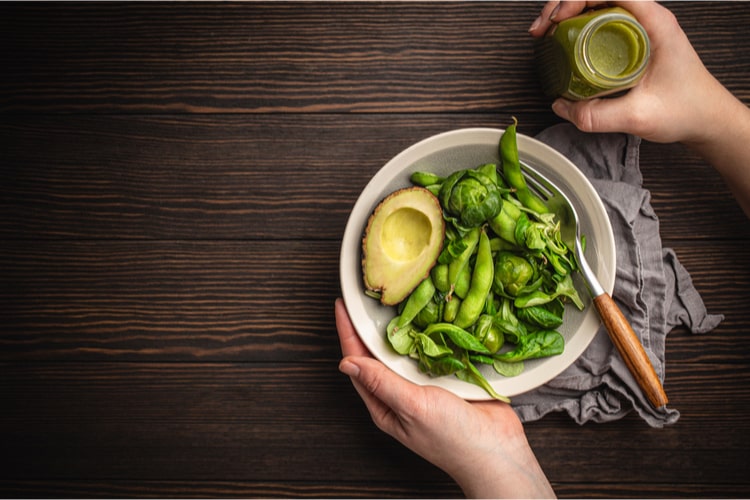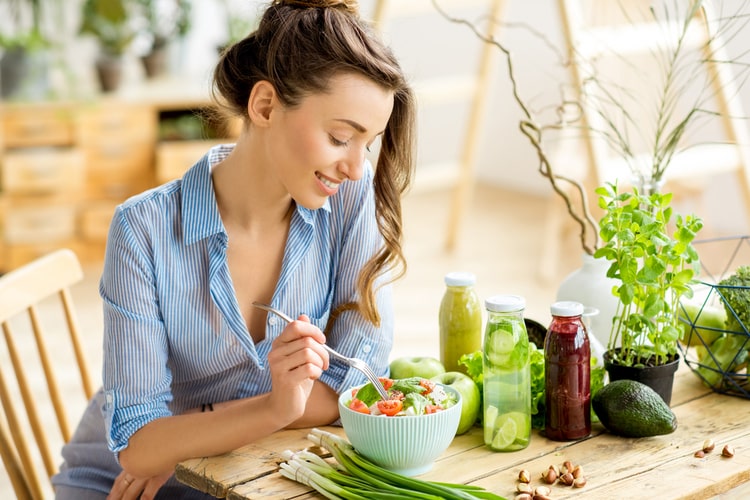While you may be familiar with vegan diets and even raw food diets, have you ever considered combining the two?
The “raw vegan diet” blends these concepts to create a plant-based, raw vegan meal plan with lots of whole foods.
Let’s explore the basics, benefits and drawbacks of the raw vegan diet to see if it’s appropriate for you. Then you can try out this diet, starting with a 7-day raw vegan meal plan below.
Raw Vegan Diet Overview
As mentioned, the raw vegan diet combines concepts of “raw food eating” and veganism. Below is a table that shows the components of the raw vegan meal plan.
Raw Vegan Diet Philosophy
| Raw Food Diet Principles | Vegan Diet Principles |
|---|---|
| Eat only raw, uncooked foods like fruits, vegetables and nuts | Avoid all animal foods like meat, poultry and seafood |
| Emphasize unprocessed foods like soaked grains and fresh juices | Avoid all animal-based foods like milk, butter, gelatin, honey and eggs |
| Eat lots of simple, whole foods | Avoid foods that contain animal ingredients and/or animal-based ingredients |
| Avoid refined sugars, packaged snack foods and bakery items | Eat only foods that come from plants, nuts and seeds |
| Raw foods contain more nutrition than cooked foods (allegedly) | Use alternative dairy sources like almond milk, soy milk and vegan cheese |
A big benefit of the raw vegan diet is that it’s high in fruits, vegetables, grains, nuts and seeds. It also emphasizes limiting processed foods for whole, more natural foods.
Is a raw vegan diet safe?
Before you jump straight into a raw vegan meal plan, there are important things to consider. This diet is not suitable for everyone. Talk to your healthcare team prior to starting.
Raw Vegan Diet Drawbacks
| Raw Food Diet Issues | Vegan Diet Issues |
|---|---|
| There’s little evidence to support that raw foods have more nutrition than properly cooked foods. 4 | Can put you at risk for nutrient deficiencies in protein, calcium, B12, iron, and vitamin D. 3 |
| Not cooking food to proper temperatures can put you at risk of foodborne illness. 2 | Not necessarily healthier than a diet that includes animal-based foods. |
| Should not be consumed by people with a compromised immune system. | Won’t make you lose more weight than a non-vegan diet (even vegan diets need a calorie restriction). |
| Requires strict, safe food handling like washing your hands, cleaning your produce and avoiding cross-contamination. 1 | Need lots of planning to make it a well-rounded diet with complete nutrition. |
How to Follow a Raw Vegan Diet
Let’s go over what you need and how to get started. Plus, don’t forget about our 7-day raw vegan meal plan below!
Step 1: Load Up on Vegan Foods
The best way to do this diet is to make sure you’re well-equipped with nutritious foods. The more variety, the more complete your nutrition profile will be. Any good vegan diet (and especially a raw vegan meal plan!) should be rich in:
- Fresh fruits
- Plain, frozen fruits
- Fresh vegetables
- Plain, frozen vegetables
- Dried fruits and vegetables
- Nuts and nut butter
- Seeds
- Whole grains (such as quinoa)
- Legumes (such as beans)
- Soy (such as edamame)
Step 2: Store Your Foods Properly
You’re supposed to eat uncooked food while on a raw vegan meal plan. But, don’t just leave stuff on your countertop.
Make sure you store items in the fridge, freezer or at room temperature, depending on the food. Here’s a handy fruit and vegetable storage guide!
Step 3: Wash Your Hands and Surfaces Before Prepping
Cooking helps to kill certain bacteria, but since the goal is to consume raw food, you’ll have to minimize contamination risk in other areas.
Wash your hands and cooking surfaces before, during and after meal prepping.
Step 4: Properly Wash and Prep Your Food
Here’s another safeguard against foodborne illness. Many fruits and vegetables should be properly rinsed and cleaned prior to eating.
Contaminants from animals, soil, water — and even bacteria on someone’s hand — can end up on your produce. That’s why it’s really important to wash your produce before cutting and peeling. Otherwise, bacteria can enter through a cut in the fruit or vegetable’s skin!
Some quick washing tips from the FDA: 1
- Rinse produce before peeling and cutting
- Only use clean, running water to rinse (no soap or soaking)
- Cut away bruised areas
- Use a vegetable brush for tough and firm produce like melons and apples
- Dry produce with a clean towel or paper towel
- Remove outer leaves of leafy vegetables like cabbage
7-Day Raw Vegan Meal Plan
Want to try the raw vegan diet? Here’s a simple raw vegan meal plan to help you get started. Remember: A true raw diet involves no heating or cooking your meals, so if you want to follow a raw vegan meal plan don’t use heat when making your meals.
Day 1
Breakfast: Chia pudding with fresh sliced peaches and raspberries. Add cinnamon, nutmeg and walnuts if desired.
Lunch: Salad bowl with julienned carrots, cabbage and zucchini. Add edamame and bell peppers. Drizzle with cold-pressed avocado oil and sesame seeds.
Dinner: Raw miso soup with marinated mushrooms, dried wakame and blended cashews for creaminess.
Snack: Mixed nuts.
Day 2
Breakfast: Cobbler with a crust made from ground almonds, coconut oil and dates (all blended in a food processor). Add mango and garnish with mint leaves and agave.
Lunch: Raw carrot zoodles topped with homemade peanut sauce, ginger and lime.
Dinner: Riced cauliflower sushi wrapped in raw nori.
Snack: Fresh fruit.
Day 3
Breakfast: Banana “sushi” (sliced banana) topped with nut butter, seeds and goji berries.
Lunch: Creamy gazpacho made from soaked cashews, coconut milk and cucumbers (all blended). Add lemon juice, garlic and other spices. Garnish with pine nuts.
Dinner: Stuffed avocado halves with chickpeas, cucumber and soaked quinoa.
Snack: Apple with homemade nut butter.
Day 4
Breakfast: Fruit skewers with pineapple, strawberries and melon. Dip into maple syrup, honey and/or chia seed pudding.
Lunch: Lettuce boats filled with avocado, tomatoes, alfalfa sprouts, julienned carrots and shredded cabbage. Add a dollop of homemade lemon-tahini dressing.
Dinner: Cauliflower rice with raw veggies and edamame. Top with lime juice and cold-pressed oil.
Snack: Banana “nice” cream (frozen banana blended with non-dairy milk).
Day 5
Breakfast: Smoothie made with banana, pineapple, non-dairy milk and ground flax seeds.
Lunch: Stuffed peppers (or mini peppers) with thick garlic, lemon and cashew schmear.
Dinner: Zoodles with avocado pesto sauce.
Snack: Homemade hummus with veggies.
Day 6
Breakfast: Raw oatmeal (soaked overnight) with homemade nut butter, apple slices and cinnamon.
Lunch: Tomato, basil and avocado salad. Slice the tomatoes and avocados into disk-shaped pieces. Top with basil and a drizzle of cold-pressed olive oil.
Dinner: Raw zucchini lasagna with tomato, hummus and pesto.
Snack: Dried fruit with nuts.
Day 7
Breakfast: Peanut butter and banana smoothie with homemade nut butter, frozen banana, unsweetened cocoa powder and soy milk.
Lunch: Veggie lettuce wraps with savory dipping sauce.
Dinner: Raw veggie pizza. Blend the crust with ground pumpkin seeds, hemp seeds, sunflower seeds, walnuts, water and lots of seasoning. Spread on a pesto blend and add raw veggies like tomato and soaked mushrooms.
Snack: Raw flaxseed crackers with guacamole.
This simple raw vegan meal plan is a great start for anyone looking to try a raw and vegan diet. If you’re interested in other raw diets, check out our raw food detox diet guide.

